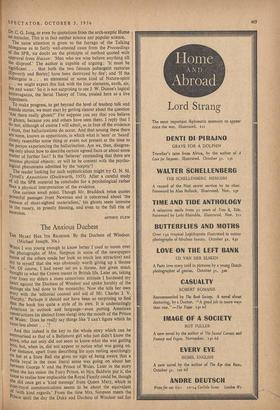Sub-Supernatural
HAUNTED HOUSES. By Joseph Braddock. (Batsford, 21s.) IN his preface the author explains that 'writers must seek to enter;• tain'; and quotes, 'Unless they please they are not heard at all.' Treated purely as entertainment this book is good value. The stories told are pleasantly ghoulish, Mr. Felix Kelly's many illustrations most excellently eerie, and the whole is well tailored to Batsford's high standards for the Christmas trade. It deserves to, and will, sell.
But the author also professes to flavour the material with a 'particular angle on the supernormal world' and presents it with flourishes and scientific-sounding patter. It would be a mistake to take this seriously. Let no one be misled by frequent respectful references to the investigations of the Society for Psychical Research, by appeal to that fashionable patron of all credulity,
Dr. C. G. Jung, or even by quotations from the arch-sceptic Hume on miracles. This is in fact neither science nor popular science.
The same attention is given to the farrago of the Talking Mongoose as to fairly well-attested cases from the Proceedings of the SPR, no doubt on the principle of method quoted with approval from Hassan: 'Men who are wise believe anything till the disproof.' The author is capable of arguing: 'It must be significant . . . that both the two famous poltergeist rectories [Epvvorth and Borley] have been destroyed by fire'; and 'If the Poltergeist is . . . an elemental or some kind of Nature-spirit . we might expect this link with the four elements, earth, air, fire and water.' So it is not surprising to see J. W. Dunne's logical extravaganza, the Serial Theory of Time, treated here as a live hypothesis.
To make progress, to get beyond the level of teashop talk and fireside stories, we must start by getting clearer about the question Are there really ghosts?' For suppose you say that you believe in ghosts, because you and others have seen them. I reply that I do not; although of course I will admit, as in face of the evidence
must, that hallucinations do occur. And that among these there are some, known as apparitions, in which what is 'seen' or 'heard' Closely resembles some thing or event not present at the time to the person experiencing the hallucination. Are we, then, disagree- ing only about how to describe certain agreed facts or about some Matter of further fact? Is the 'believer' contending that there are tenuous physical objects: or will he be content with the psycho- logical phenomena admitted by the 'sceptic'? The reader looking for such sophistication might try G. N. M. Tyrrell's Apparitions (Duckworth, 1953). After a careful study Of all the SPR material he concludes for a psychological rather than a physical interpretation of the evidence. One curious small point. Though Mr. Braddock twice quotes Powerful passages from Newman and is concerned about 'the menace of short-sighted materialism,' his ghosts seem immune to the rosary, to priestly blessing, and even to the full rite of exorcism.
ANTONY FLEW



















































 Previous page
Previous page